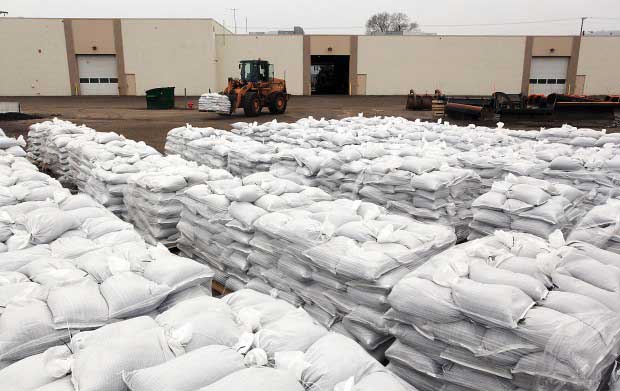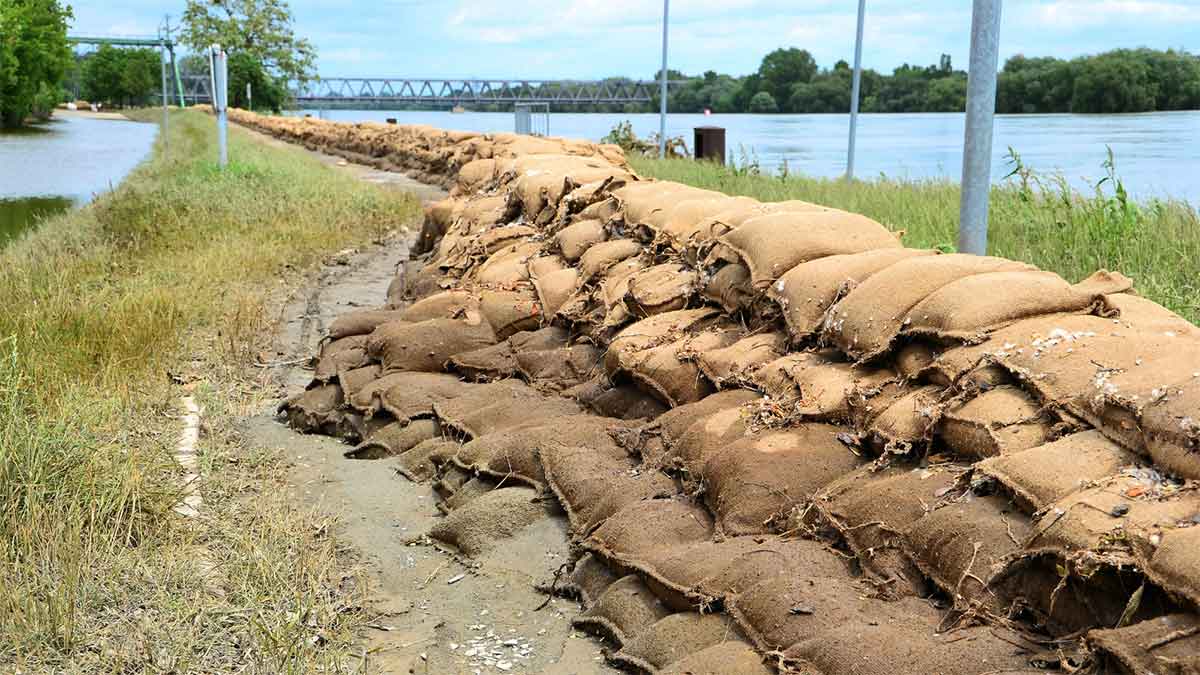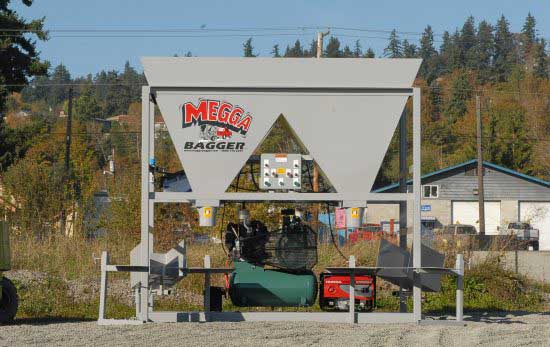Flooding remains one of the most damaging challenges in agriculture. Heavy rains and overflowing water sources can quickly lead to soil erosion, crop loss, and long-term damage to farmland.
These unpredictable conditions leave many farmers struggling to protect their property and maintain productivity. One simple yet effective solution that has proven valuable over time is the use of sand bags. But how exactly can these bags help reduce flood-related risks on your farm?
Soil Protection
When heavy rain hits farmland, one of the first things at risk is the topsoil which is the most nutrient-rich layer. Without protection, water can easily wash it away, leaving crops deprived of the organic matter and minerals they need. Sandbags provide a simple yet highly effective solution.
By placing them along the edges of fields or around planting beds, farmers can slow the force of surface runoff. These barriers help reduce soil displacement, especially on sloped or newly tilled areas. As a result, the integrity of the soil structure is preserved, helping maintain soil health and long-term productivity.
Erosion Control
In exposed agricultural land, both wind and water can gradually strip away valuable topsoil. One smart solution involves the use of bags of sand in tandem with an erosion fence. These tools form a protective boundary that buffers the land from high winds and flowing water.
Especially in transitional seasons where fields may be bare or between planting cycles, this combination limits erosion while promoting better water retention. Over time, it supports more sustainable field conditions by holding nutrients in place and allowing soil microbes to thrive.
Enhancing Drainage Systems
Waterlogged fields are a common issue after storms or in areas with poor drainage. When water sits too long, it can lead to root rot, fungal diseases, and limited oxygen in the soil. With sandbags for flooding, farmers gain control over excess water by directing its flow away from sensitive zones.
Used strategically around low-lying areas or at the edge of drainage ditches, they prevent puddling and help maintain healthy moisture levels in the field. This can mean the difference between a thriving crop and a compromised yield.
Controlling Water Flow
Whether dealing with irrigation runoff or heavy rain, managing the direction and volume of water on farmland is crucial. Sandbags offer a temporary yet customizable way to guide water. By stacking them to create mini barriers, channels, or redirecting points, farmers can fine-tune how water moves across their land.
These setups help prevent flooding in vulnerable sections, protect newly seeded rows, and create opportunities for more efficient water absorption in dry patches. The flexibility of this tool makes them a valuable resource for water control in ever-changing field conditions.
Supporting Greenhouses and Structures
Temporary greenhouses, high tunnels, and low tunnels are often lightweight and vulnerable to shifting or collapsing in high winds. Anchoring them with sandbags is a practical and low-cost solution. Placed along the base or corners, they keep plastic sheeting tight and frames grounded without permanent fixtures.
This is particularly useful for seasonal structures that need to be relocated or removed. Additionally, flood bags can serve as barriers to direct water away from the foundation of these structures, further supporting plant health inside.
Protection Against Pests
While sandbags are commonly seen as flood or weight-control tools, they can also help with pest control. By placing low-level sandbag barriers around planting beds or greenhouses, farmers can deter crawling insects and small animals from entering crop zones. The physical barrier is often enough to disrupt the path of ants, snails, and rodents.
Though not a standalone pest solution, using sandbags as part of a broader prevention strategy helps reduce the chances of damage, particularly when combined with other organic pest management methods.
Minimizing Wind Erosion
In dry, flat, or fallow fields, high winds can erode soil over time, reducing fertility and damaging future crop prospects. One effective way to address this issue is by using sandbags around the perimeter of exposed land.
These act as a windbreak and reduce the speed at which wind hits the soil surface. As wind erosion decreases, soil moisture and structure are preserved. This approach is especially helpful in newly tilled fields or areas awaiting planting, where protective vegetation may not yet be established.
Improving Irrigation Efficiency
With thoughtful placement, sandbags enhance irrigation practices by guiding water exactly where it’s needed. In furrow or flood irrigation systems, they are used to create blockages or dividers, ensuring water stays within targeted rows. This prevents overwatering and allows more precise distribution.
It also makes sure crops receive optimal hydration without wasting resources. Over time, this increases yield and lowers water usage costs, a key goal in modern farming operations.
Crop Support
Many crops during early growth stages are vulnerable to physical damage from wind, rain, or shifting row covers. Farmers use sand bags to secure crop-protection materials like tarps, plastic covers, or floating row fabric. These barriers weigh down the edges and prevent wind from lifting or displacing the cover.
Beyond anchoring, these bags can also be positioned around delicate plants to reduce direct exposure to harsh weather or grazing pests. This form of crop support is adaptable and can be reused season after season.
Creating Contour Sandbags for Sloped Fields
Farms on hilly or uneven terrain face challenges in managing water flow and erosion. By creating contour lines with sandbags, farmers can slow down rainwater and encourage gradual absorption.
This technique also supports moisture retention along slopes. These sandbag lines act like mini-terraces, helping to protect the topsoil and promote more even plant growth across different elevation levels.
Constructing Sandbag Dams for Water Retention
For areas without built-in reservoirs, constructing small sandbag dams provides a way to collect and store water after rain or irrigation. These structures are especially useful in dry seasons or for regulating how much water reaches different sections of a field.
Unlike permanent dams, they can be moved, adjusted, or expanded depending on current water needs. This adaptability helps farmers stay prepared for both shortages and excess, contributing to a more stable farming cycle.
Implementing Sandbag Techniques for Sustainable Agricultural Practices
Flooding, soil erosion, and water mismanagement are common challenges farmers face—often worsened by changing weather patterns. Using sand bags in strategic ways can offer more than just emergency flood control. These simple, reusable tools also support long-term, eco-friendly solutions that protect the land, improve water use, and boost crop success. While military sandbags are often seen in defense settings, their durability and design are now finding valuable applications in farming. So how can growers integrate sandbags into everyday agricultural routines without waste?
Here are five sustainable tips:
- Create Temporary Soil Berms
Use filled sand bags to shape small berms around planting areas or along field edges. These act as barriers that reduce erosion and nutrient loss. When placed correctly, they help redirect water to where it’s most needed, giving crops a steady and manageable water supply. - Anchor Mulch Covers and Row Tunnels
In windy areas, sandbags offer a natural and cost-effective anchor for plastic mulch, shade cloths, or tunnel covers. They keep materials in place without tearing into the ground or damaging plants. This allows for faster installation and removal between planting cycles. - Use a Sandbag Filler Machine for Efficiency
Filling each sandbag by hand can take time and slow down large projects. A sandbag machine speeds up the process by producing filled sand bags consistently and quickly. For farms using sandbags across multiple fields or seasons, this tool saves time, cuts labor costs, and supports repeatable use without delays.
Where to Find Sand Bags
If you’re looking for dependable sand bags for agriculture, flood control, or commercial use, The Bag Lady offers reliable solutions backed by strong production capacity and modern equipment.
We manufacture and distribute both empty and pre-filled sandbags made from durable polypropylene or burlap. Each one includes UV protection for up to 2,000 hours, roughly three months of outdoor exposure. Our bags also feature hemmed tops and drawstrings for secure closure and are made to last.
To meet large-scale demands, The Bag Lady produces up to 12,000 units per day and ships by pallet or in bulk bags. Whether you need a few dozen or thousands for a major project, we can fulfill your order quickly and efficiently.
Built for Durability and Versatility
Our sandbags are made to withstand environmental stress. Polypropylene construction offers resistance to tearing and UV degradation, while burlap options provide a breathable, biodegradable alternative for short-term use.
Fast Production and Bulk Delivery
We understand time matters. Whether you’re preparing for a flood or reinforcing an agricultural structure, our production schedule can meet urgent needs without compromising quality. Bulk shipping options help you get what you need, where you need it.
Efficient Sandbag Filler Machines
The Bag Lady also provides access to the Megga Bagger—our automatic sandbag filler machine. It fills bags in as little as 1 to 10 seconds and handles a variety of materials, including sand, gravel, and small rocks. You can choose a model with one or two hoppers to increase productivity and reduce manual effort. For even bigger jobs, our Megga Bagger bulk filler can fill bags from 500 to 5,000 lbs. at a rate of up to 40 bags per hour.
If you’re preparing for flood season, reinforcing agricultural systems, or managing large-scale site protection, The Bag Lady has the tools and supply power to support your efforts.
Take a smarter, faster approach to flood prevention or land management, let’s talk about how we can help you gear up—with the right bags, the right equipment, and a partner who gets the urgency. Reach out to The Bag Lady and get exactly what your project calls for without delays.



